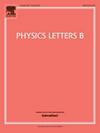用SN Ia和BAO观测资料在Bianchi I时空约束f(R,Lm)重力
IF 4.5
2区 物理与天体物理
Q1 ASTRONOMY & ASTROPHYSICS
引用次数: 0
摘要
在本研究中,我们探讨了f(R,Lm)引力框架在局部旋转对称(LRS) bichi - i时空背景下解释宇宙加速膨胀的可行性。修正的引力理论已经成为广义相对论(GR)的有希望的替代品,以解释宇宙加速和暗能量现象。我们使用Ia型超新星(SN Ia)、重子声学振荡(BAO)和宇宙天文钟(CC)的观测约束来校准我们模型的自由参数。根据f(R,Lm)的特定泛函形式建立了场方程,并得到了解析解。利用哈勃参数、减速参数(q)、状态检测器诊断参数(r,s)和扰动参数(j)来分析宇宙的演化动力学。我们的研究结果表明,从减速阶段过渡到加速阶段,过渡红移zt=0.7293−0.06+0.07,目前的减速参数q0=−0.56,与观测数据一致。在这个框架下,宇宙的估计年龄为13.27±0.26 Gyrs。寻态器参数表明,该模型与目前的标准ΛCDM情景非常接近,但在早期时期出现偏差,可能表明暗能量具有动态性质。Om的诊断进一步证实了我们的模型与暗能量的幽灵行为的兼容性。这些发现支持了f(R,Lm)引力作为解释宇宙加速的另一种框架的可行性,在引力动力学中提供了物质和曲率之间新的相互作用。本文章由计算机程序翻译,如有差异,请以英文原文为准。
Constraining f(R,Lm) gravity with SN Ia and BAO observational data in Bianchi I space time
In this study, we investigate the viability of the gravity framework in explaining the accelerated expansion of the universe within the context of the locally rotationally symmetric (LRS) Bianchi-I space-time. Modified gravity theories have emerged as promising alternatives to General Relativity (GR) to account for cosmic acceleration and dark energy phenomena. We employ observational constraints from Type Ia Supernovae (SN Ia), Baryon Acoustic Oscillations (BAO), and Cosmic Chronometers (CC) to calibrate the free parameters of our model. The field equations are formulated based on a specific functional form of , and analytical solutions are obtained. The Hubble parameter, deceleration parameter (), statefinder diagnostics , and the jerk parameter () are utilized to analyze the evolutionary dynamics of the universe. Our results indicate a transition from a decelerating to an accelerating phase, with the transition redshift and present deceleration parameter , consistent with observational data. The estimated age of the universe in this framework is Gyrs. The statefinder parameters suggest that the model closely mimics the standard CDM scenario at present but exhibits deviations at earlier epochs, potentially indicating a dynamic nature of dark energy. The diagnostic further confirms the compatibility of our model with a phantom-like behavior of dark energy. These findings support the viability of gravity as an alternative framework for explaining cosmic acceleration, providing new interplay between matter and curvature in gravitational dynamics.
求助全文
通过发布文献求助,成功后即可免费获取论文全文。
去求助
来源期刊

Physics Letters B
物理-物理:综合
CiteScore
9.10
自引率
6.80%
发文量
647
审稿时长
3 months
期刊介绍:
Physics Letters B ensures the rapid publication of important new results in particle physics, nuclear physics and cosmology. Specialized editors are responsible for contributions in experimental nuclear physics, theoretical nuclear physics, experimental high-energy physics, theoretical high-energy physics, and astrophysics.
 求助内容:
求助内容: 应助结果提醒方式:
应助结果提醒方式:


